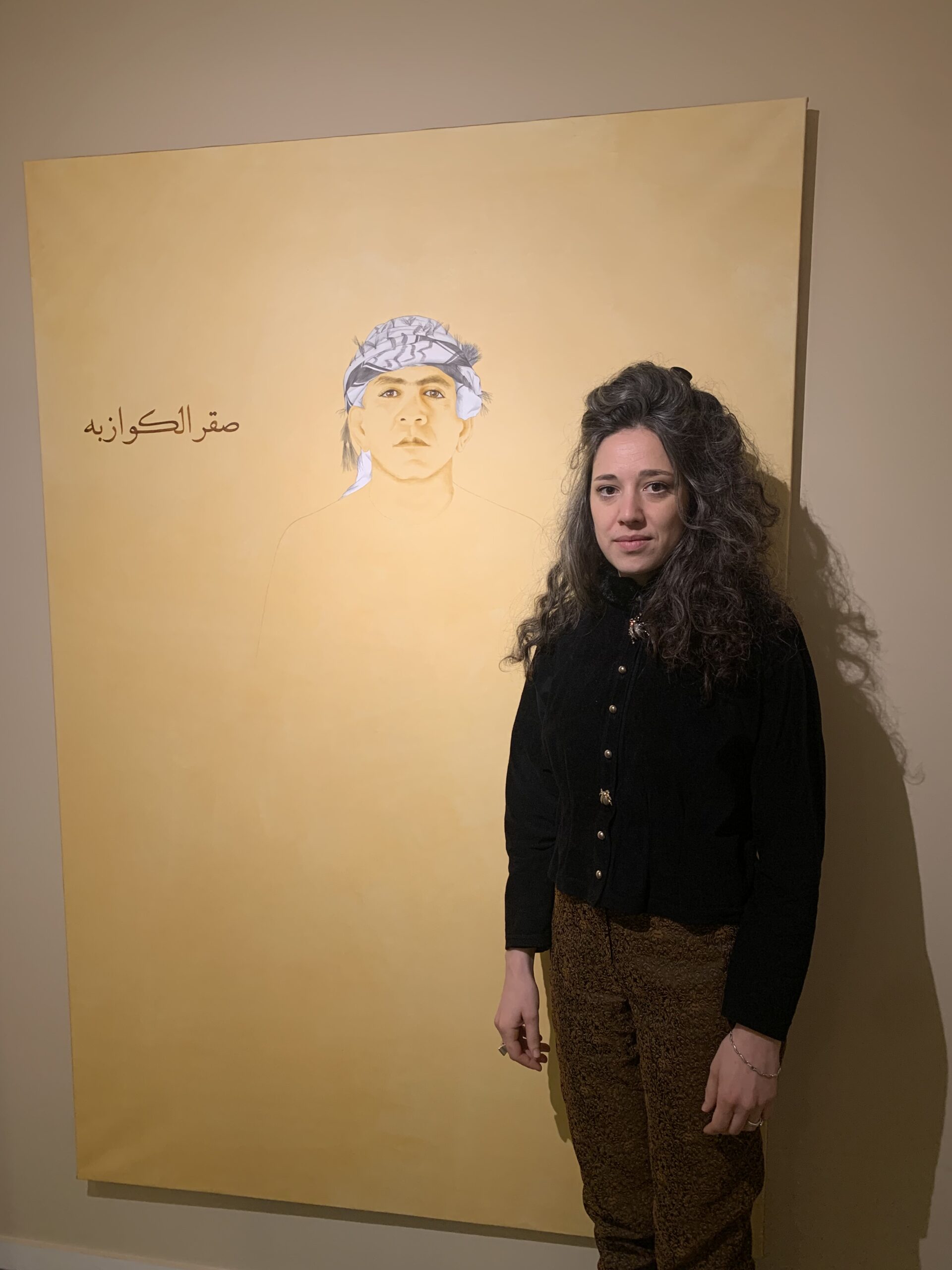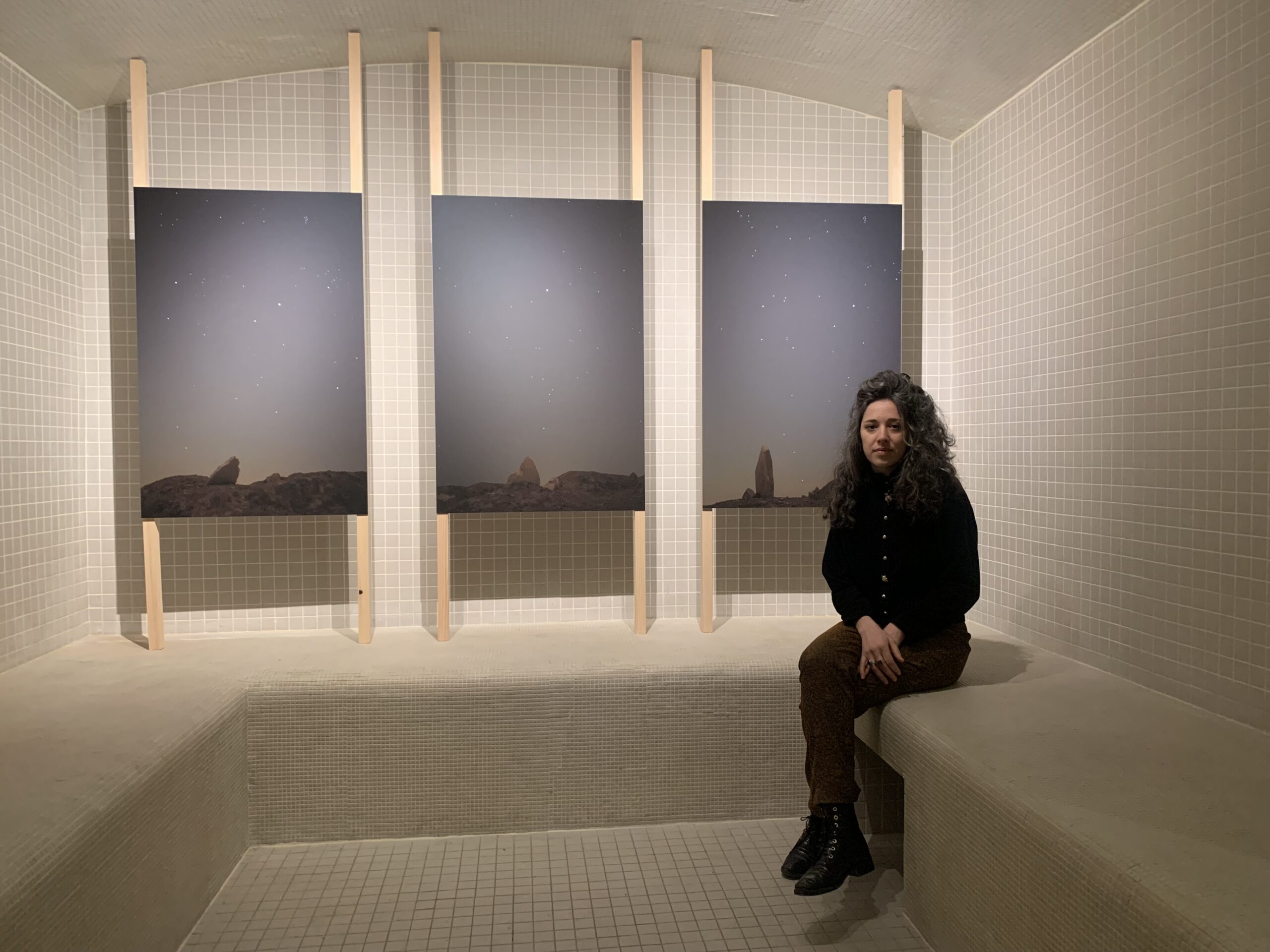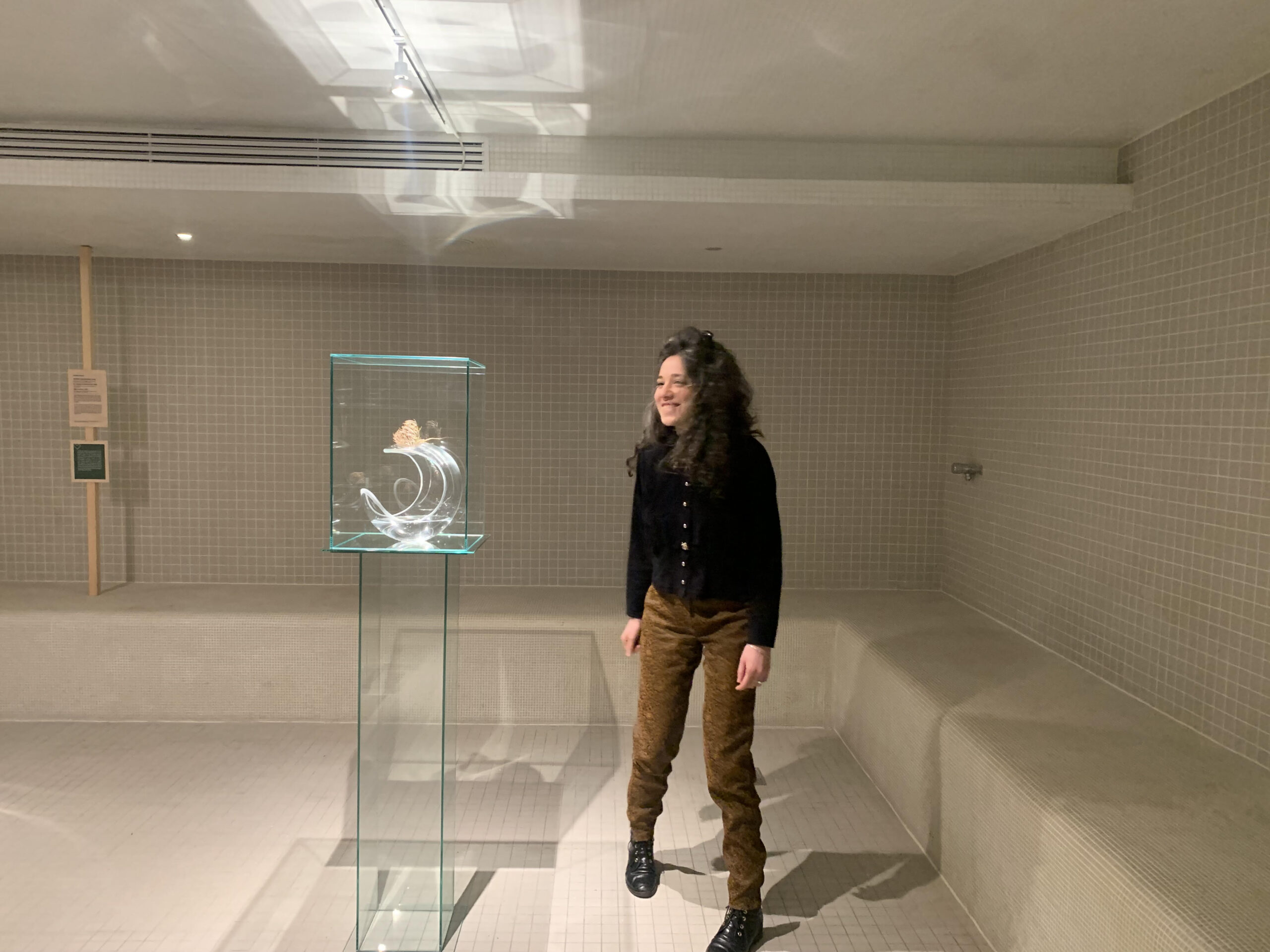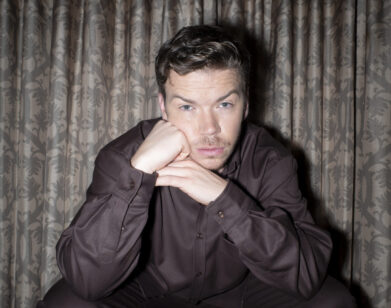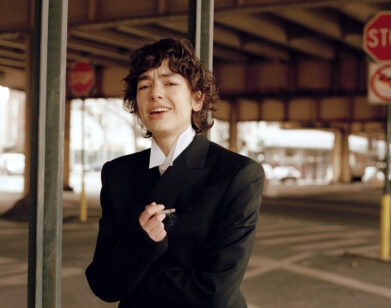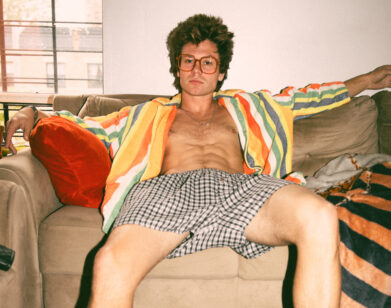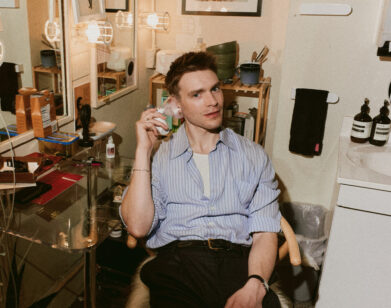OPENING
Aurélia Zahedi Is on a Quest to Find the Rose of Jericho
Several years ago, after coming across Aurélia Zahedi’s herbariums and glitter-soaked canvases, I traveled to meet the artist at Maison Auriolles. A crumbling chateau on the Lot River in Southwest France, there Zahedi has established a residency with other artists, musicians and a farmer who trains donkeys for use in organic agriculture. We were somewhere inside France’s series of strict pandemic lockdowns, and, unable to carry on with her quest for the Rose of Jericho, Zahedi was practicing the organ in local churches and studying historical paintings of the holy family’s flight to Egypt.
When Zahedi was a child, her father, a rare plant collector, would share stories about specimens he kept in his greenhouse. But he hadn’t known the story of the Rose of Jericho. “For once I decided that I would tell him the story myself,” Zahedi explained. Certain Catholic monks say that, in each place the Virgin Mary’s foot touched ground on the holy family’s journey from Bethlehem, a Rose of Jericho, or Kaff Maryam, as the Muslin Bedouins call it, grew.
On the eve of Zahedi’s first solo exhibition in Paris, opening in the hammam of the Institut des Cultures de l’Islam, I met with her to talk about the Rose of Jericho, her journeys to Palestine in search of this rare plant, as well as Saqer, the Bedouin man who has become her guide. For Zahedi, “he’s really the one who opened up the desert.”
———
LILLIAN DAVIES: We’ve just come out of the hammam at the Institut des Cultures d’Islam, here on Rue Stephenson. I have wonderful memories of visiting you at Maison Auriolles in 2021 and learning about the Rose de Jericho. I will always remember one morning when I woke up in the house of Maison Auriolles and you had left a little note on a pink paper on the kitchen table saying, “I’ve gone to go play the organ and I’ll be back later.” Maybe I can ask you to go back to the beginning of the story. Why the Rose of Jericho?
AURÉLIA ZAHEDI: As a kid, my father was always telling me stories about his collection of plants, and he was always showing them to me in his greenhouses.
DAVIES: He specialized in exotic plants in Lyon, right?
ZAHEDI: That’s correct. In his greenhouse, he had a Rose of Jericho, but he didn’t know her story, so for once I decided that I would tell the story to him myself. I started by meticulously collecting texts, myths, legends around her. There are lots of beliefs around this plant.
DAVIES: I remember, too, when I went to visit you at the Maison… in French, a house is feminine: la maison. But with Maison Auriolles, you didn’t want it to be feminine. You cut the gender denomination, so Maison is neutral but the Rose of Jericho is distinctly feminine. Why is that important to you?
ZAHEDI: The Rose of Jericho is a plant that is really linked to women. There are lots of legends around how she is related to women. She’s also used by women in medicinal ways. To enhance fertility, to cope with menstrual pain, and she’s also used during—
DAVIES: Childbirth.
ZAHEDI: Exactly. During my quest, I realized that there are three different plants called Rose de Jericho that are not living in the city of Jericho itself. They’re coming from different parts of the world. One of them comes from Mexico, which is called Selaginella lepidophylla, and the other two, which are called Anastatica hierochuntica and Asteriscus pygmaeus, are both found in North Africa and the Middle East.
DAVIES: But not Jericho. And Jericho is a site that’s particularly of interest to you.
ZAHEDI: Jericho has a specific meaning for me in this project. Because in books and in the imaginary, the plant is called Rose de Jericho, I decided to make her live there and to imagine her life there.
DAVIES: When we talked in 2021, you had already made several trips to this area of Palestine, accompanied by a Bedouin tribe. You had just secured funds from the Fanak Fund and you were preparing a trip back, but things were complicated with the pandemic. We haven’t spoken since you went again. Can you tell me about your trips?
ZAHEDI: Since the beginning of the project, I’ve been quite regularly traveling to Jericho. I’d been there twice a year until the pandemic, and then of course, I had to wait a bit before being able to travel back. The work is also paused because it’s so influenced by what is happening on site. With the current situation, I don’t know when I’ll be able to go back.
DAVIES: It’s interesting that the work closes up when you’re not able to go. It’s functioning like the plant itself. When you’re able to put your feet on the sand in Jericho, then the project opens, it expands. You’re able to make this incredible film that we see downstairs amongst the green tile of the hammam, between the closed shower heads. But when you come back, the project is in hibernation. It’s a beautiful metaphor. I love that we come down the stairs to the hammam, and right away we meet a beautiful, one-to-one scale portrait. Is that Saqer that we meet?
ZAHEDI: Yes. Saqer welcomes us in the exhibition as soon as we enter. Saqer is a Bedouin from the desert around Nabi Moussa, the Bedouin cemetery, and he is a very significant person for this project. He’s really the one that opened up the desert for me.
DAVIES: He’s gorgeous, by the way.
ZAHEDI: [Laughs] And he gave me the clues to understand Bedouin culture.
DAVIES: When we did the visit before, you said that his name means “eagle.” I love that you get the sense of regality, but also this visibility, soaring above.
ZAHEDI: Yes. Saqer means eagle in the Bedouin language. Whenever there are issues on their territory, Saqer always says that they will make it because they are eagles.
DAVIES: You were so brave, going on your own to understand the Rose of Jericho. How did you meet?
ZAHEDI: So I went to visit Nabi Moussa, a burial site in the desert, and there I met Saqer and his camel, Chouchou.
DAVIES: The camel was called Chouchou?
ZAHEDI: Chouchou, yes.
DAVIES: Which in French means “cutie.”
ZAHEDI: It’s more like “honey.” [Laughs] This was really the starting point of a reorientation of the entire project. Saqer’s portrait welcomes us to the exhibition because it is with Saqer that I am creating and writing the myth around the Rose.
DAVIES: You told me that during the Virgin Mary and Joseph and baby Jesus’ exile to Egypt, there is a myth in the Christian tradition that every step that Mary placed her foot down, a Rose of Jericho plant bloomed. You were looking to find images in historic paintings of the foot of Mary. There are some paintings where you just see a little bit of her heel, and others, she’s barefoot. Sometimes the foot is enormous, sometimes it’s tiny. But she never rests on this journey.
ZAHEDI: I had this desire to envision that journey from Bethlehem to Egypt and to see where the first Roses of Jericho were born. The Bedouins have orally tried to define which path the holy family has followed to reach Egypt from Bethlehem. All this is not yet manifested in an artwork, and there is not a known route that the holy family would’ve taken. It’s purely about imagination. There are texts by monks, for instance, who have tried to define this path, and Bedouins say that they are wrong because the monks are not from the desert. There is even some disagreement among Bedouins themselves.
DAVIES: It’s fascinating that access to a certain geography gives you access to storytelling.
ZAHEDI: But in imagining this path, we are really trying to situate it in the current context, which is the context of a land that is obstructed with checkpoints and borders and military bases and settlements. In imagining the route in the present day, we have to cope with these constraints and imagine how the holy family could pass through with all these restrictions, because today’s desert has walls.
DAVIES: Today this sort of voyage is impossible.
ZAHEDI: It is impossible, but dreams are possible.
DAVIES: The dream is very important in this exhibition, too. In one of the last rooms, you have three paintings, “The Prayer of Nesrine.” You said that her prayer came to you in a dream. Who is Nesrine?
ZAHEDI: Nesrine is a woman that was taking care of me in the Bedouin camps. We are really weaving a long-term relationship. Sometimes she also came and prayed next to me. So I dreamed an imaginary prayer and I ended up writing it in the form of a verse poem that essentially says, “Could the sky wash our inhumanity from the earth?”
DAVIES: It’s beautiful, thinking about the sky in this very purifying way.
ZAHEDI: I really see these paintings as nocturnal mirages. They’re between dream and reality, and Nesrin is opening up the night for us.
DAVIES: Fantastic. And they’re just beautiful as works, because you studied the technique of Persian miniature painting to make these. Where did you learn to do that?
ZAHEDI: I’ve always been really influenced by Persian miniature because my father is Iranian. What I find particularly striking in miniature is the way it brings together writing and image. In my own practice, there is a very strong integration of writing and text into my visual production. I’ve been learning with a miniaturist master, but Persian miniature is really codified. It has lots of strict rules that I don’t always respect.
DAVIES: And you also have the beautiful relics in glass of sand that you’ve collected around Jericho. It makes me think of your collection of animal corpses in Maison Auriolles. What sort of relics are you making now?
ZAHEDI: I really consider the Rose as a saint, she’s holy. In this way, I’m really influenced by Catholic Christian relics. Wherever I find a Rose, I try to collect some natural elements that have touched the Rose, so the earth on which the Rose has been traveling is also holy and sacred. It’s inspired by Christian relics that contain remains of saints and objects that the saints touched. In Palestine, the earth is really considered as sacred and holy because it’s also the birthplace of the three monotheistic religions. I’m drawing inspiration from all the different mythology that comes from this region that relate to the Rose of Jericho.
DAVIES: And what is the place of the Rose of Jericho in Islam?
ZAHEDI: I don’t know precisely, but Bedouins are Muslim, and they call the plant Kaff Maryam, which means “the palm of the hand of Mary.” There is a legend that says that when Mary bent down to the earth to pick up her cloth, her hand touched the earth and a Rose flowered.
DAVIES: It’s interesting that the Christian tradition says where her foot touched the earth, the Rose of Jericho blooms, and in the Islamic tradition, it’s where her hand touched the earth.
ZAHEDI: So the Rose of Jericho is a plant of women, as we said earlier, and in these religions as a figure of Mary, she’s really important. To my knowledge, the plant has at least 32 names, maybe more. And each of these 32 names has a specific story, so there are at least 32 different tales related to these names.
DAVIES: That makes me think about language. When we were talking earlier, you said that the language of plants is Latin.
ZAHEDI: It’s more like an imposition that started in the 18th century. The naturalist Carl Linnaeus used Latin to define and classify plants. There have been lots of scientific quarrels about which Rose of Jericho is the true one, so many scientists have tried to impose their own names to the plant through the Latin taxon.
DAVIES: But then in the exhibition itself, besides the signage in French, the calligraphy that you have on the wall is in Arabic. What are those phrases?
ZAHEDI: So these phrases that you see interspersed in the exhibition were a collaboration with my miniaturist master. The ink that is used for these calligraphies is reminiscent of the earth from the desert, but somehow its quality is a bit wet, as if the earth of the desert had been wet by rain.
DAVIES: It fits wonderfully to where we are now at the hammam.
ZAHEDI: Yes, the invitation to unravel the Rose in the hammam was really, really significant for me because the hammam is a place of water, as you said, and it’s a place where there can be an awakening. It’s really important that the Rose opens up in the hammam through contact with water because she can then release her stories. She’s really a witness of the desert.
DAVIES: I understand that an outside organizer will come in and open this hammam again after your exhibition. I love the hammam, especially on a cold, snowy day like this in Paris. I don’t know if there are many hammams in New York anymore, but in France it’s quite a mainstay coming from Arab and Islamic tradition.
ZAHEDI: Oui, exactement.
DAVIES: So the ceremony for the opening of the Rose of Jericho will happen here on March 30th and also June 1st. That will happen in the hammam, and you will make the Rose of Jericho have contact with water.
ZAHEDI: Yes. I’ll pour water on the Rose, which opens up, and while she opens, I recite stories and share tales about her. The ceremonies generally last an hour and 15 minutes and they will be held in French, but whenever possible, I also invited Saqer to come with me and participate in the ceremonies to recite in Arabic, without any translation. It’s very significant for Saqer to participate because Bedouins are witnesses to the desert and the Rose, and keeping things in Arabic is important—
DAVIES: The Bedouin culture is disappearing.
ZAHEDI: It’s important to acknowledge the alteration and obliteration of the Bedouin culture in the current context.
DAVIES: Is it hard for Saqer to travel to France?
ZAHEDI: It is always really tough for the Bedouins to get out of Palestine, and even more so now. Today it is impossible.
DAVIES: Impossible. Are you still in contact with Saqer at the moment?
ZAHEDI: Yes, I try to call him every week and we exchange a lot. Not really about what’s going on there, because it’s hard to do so by phone. Saqer is really present through the art.
DAVIES: His heart is with us.
ZAHEDI: Yes.

